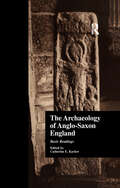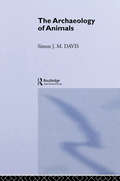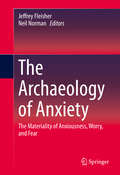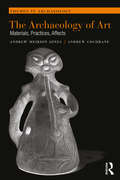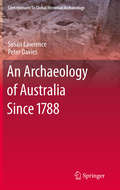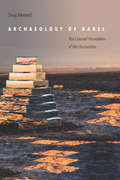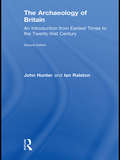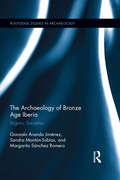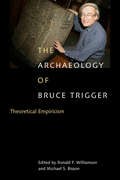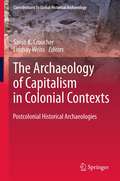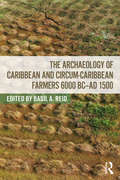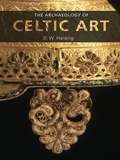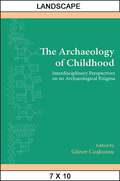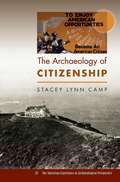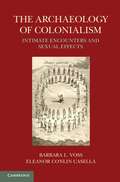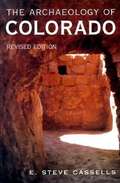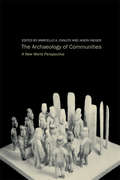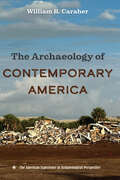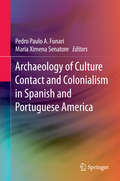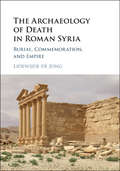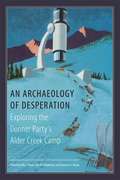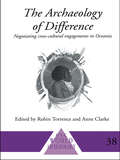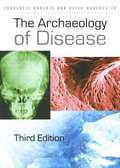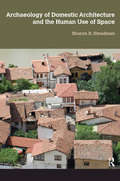- Table View
- List View
The Archaeology of Anglo-Saxon England: Basic Readings (Basic Readings in Anglo-Saxon England #9)
by Catherine E. KarkovThis volume offers comprehensive coverage of the archaeology of Anglo-Saxon England, bringing together essays on specifi fields, sites and objects, and offering the reader a representative range of both traditional and new methodologies and interdisciplinary approaches to the subject.
The Archaeology of Animals
by Simon J. DavisEver since the discovery of fossil remains of extinct animals associated with flint implements, bones and other animal remains have been providing invaluable information to the archaeologist. In the last 20 years many archaeologists and zoologists have taken to studying such "archaeofaunal" remains, and the science of "zoo-archaeology" has come into being. What was the nature of the environment in which our ancestors lived? In which season were sites occupied? When did our earliest ancestors start to hunt big game, and how efficient were they as hunters? Were early humans responsible for the extinction of so many species of large mammals 10-20,000 years ago? When, where and why were certain animals first domesticated? When did milking and horse-riding begin? Did the Romans influence our eating habits? What were sanitary conditions like in medieval England? And could the terrible pestilence which afflicted the English in the seventh century AD have been plague? These are some of the questions dealt with in this book. The book also describes the nature and development of bones and teeth, and some of the methods used in zoo-archaeology.
The Archaeology of Anxiety
by Jeffrey Fleisher Neil NormanRecent efforts to engage more explicitly with the interpretation of emotions in archaeology have sought new approaches and terminology to encourage archaeologists to take emotions seriously. This is part of a growing awareness of the importance of senses--what we see, smell, hear, and feel--in the constitution and reconstitution of past social and cultural lives. Yet research on emotion in archaeology remains limited, despite the fact that such states underpin many studies of socio-cultural transformation. The Archaeology of Anxiety draws together papers that examine the local complexities of anxiety as well as the variable stimuli--class or factional struggle, warfare, community construction and maintenance, personal turmoil, and responsibilities to (and relationships with) the dead--that may generate emotional responses of fear, anxiousness, worry, and concern. The goal of this timely volume is to present fresh research that addresses the material dimension of rites and performances related to the mitigation and negotiation of anxiety as well as the role of material culture and landscapes in constituting and even creating periods or episodes of anxiety.
The Archaeology of Art: Materials, Practices, Affects (Themes in Archaeology Series)
by Andrew Meirion Jones Andrew CochraneHow can archaeologists interpret ancient art and images if they do not treat them as symbols or signifiers of identity? Traditional approaches to the archaeology of art have borrowed from the history of art and the anthropology of art by focusing on iconography, meaning, communication and identity. This puts the archaeology of art at a disadvantage as an understanding of iconography and meaning requires a detailed knowledge of historical or ethnographic context unavailable to many archaeologists. Rather than playing to archaeology’s weaknesses, the authors argue that an archaeology of art should instead play to archaeology’s strength: the material character of archaeological evidence. Using case studies - examining rock art, figurines, beadwork, murals, coffin decorations, sculpture and architecture from Europe, the Americas, Asia, Australia, and north Africa -the authors develop an understanding of the affective and effective nature of ancient art and imagery. An analysis of a series of material-based practices, from gesture and improvisation to miniaturisation and gigantism, assembly and disassembly and the use of distinctions in colour enable key concepts, such as style and meaning, to be re-imagined as affective practices. Recasting the archaeology of art as the study of affects offers a new prospectus for the study of ancient art and imagery.
An Archaeology of Australia Since 1788 (Contributions To Global Historical Archaeology)
by Peter Davies Susan LawrenceThis volume provides an important new synthesis of archaeological work carried out in Australia on the post-contact period. It draws on dozens of case studies from a wide geographical and temporal span to explore the daily life of Australians in settings such as convict stations, goldfields, whalers' camps, farms, pastoral estates and urban neighbourhoods. The different conditions experienced by various groups of people are described in detail, including rich and poor, convicts and their superiors, Aboriginal people, women, children, and migrant groups. The social themes of gender, class, ethnicity, status and identity inform every chapter, demonstrating that these are vital parts of human experience, and cannot be separated from archaeologies of industry, urbanization and culture contact. The book engages with a wide range of contemporary discussions and debates within Australian history and the international discipline of historical archaeology. The colonization of Australia was part of the international expansion of European hegemony in the eighteenth and nineteenth century. The material discussed here is thus fundamentally part of the global processes of colonization and the creation of settler societies, the industrial revolution, the development of mass consumer culture, and the emergence of national identities. Drawing out these themes and integrating them with the analysis of archaeological materials highlights the vital relevance of archaeology in modern society.
Archaeology of Babel: The Colonial Foundation of the Humanities
by Siraj AhmedFor more than three decades, preeminent scholars in comparative literature and postcolonial studies have called for a return to philology as the indispensable basis of critical method in the humanities. Against such calls, this book argues that the privilege philology has always enjoyed within the modern humanities silently reinforces a colonial hierarchy. In fact, each of philology's foundational innovations originally served British rule in India. Tracing an unacknowledged history that extends from British Orientalist Sir William Jones to Palestinian American intellectual Edward Said and beyond, Archaeology of Babel excavates the epistemic transformation that was engendered on a global scale by the colonial reconstruction of native languages, literatures, and law. In the process, it reveals the extent to which even postcolonial studies and European philosophy—not to mention discourses as disparate as Islamic fundamentalism, Hindu nationalism, and global environmentalism—are the progeny of colonial rule. Going further, it unearths the alternate concepts of language and literature that were lost along the way and issues its own call for humanists to reckon with the politics of the philological practices to which they now return.
The Archaeology of Britain: An Introduction from Earliest Times to the Twenty-First Century
by John Hunter Ian RalstonThe Archaeology of Britain is the only concise and up-to-date introduction to the archaeological record of Britain from the reoccupation of the landmass by Homo sapiens during the later stages of the most recent Ice Age until last century. This fully revised second edition extends its coverage, including greater detail on the first millennium AD beyond the Anglo-Saxon domain, and into recent times to look at the archaeological record produced by Britain’s central role in two World Wars and the Cold War. The chapters are written by experts in their respective fields. Each is geared to provide an authoritative but accessible introduction, supported by numerous illustrations of key sites and finds and a selective reference list to aid study in greater depth. It provides a one-stop textbook for the entire archaeology of Britain and reflects the most recent developments in archaeology both as a field subject and as an academic discipline. No other book provides such comprehensive coverage, with such a wide chronological range, of the archaeology of Britain. This collection is essential reading for undergraduates in archaeology, and all those interested in British archaeology, history and geography.
The Archaeology of Bronze Age Iberia: Argaric Societies (Routledge Studies in Archaeology)
by Gonzalo Aranda Jimenez Sandra Montón Subías Margarita Sánchez RomeroAfter more than a century of research, an enormous body of scientific literature in the field of El Argar studies has been generated, comprising some 700 bibliographic items. No fully-updated synthesis of the literature is available at the moment; recent works deal only with specific characteristics of Argaric societies or some of the regions where their influence spread. The Archaeology of Bronze Age Iberia offers a much-needed, comprehensive overview of Argaric Bronze Age societies, based on state-of-the-art research. In addition to expounding on recent insights in such areas as Argaric origin and expansion, social practices, and socio-politics, the book offers reflections on current issues in the field, from questions concerning the genealogy of discourses on the subject, to matters related to professional practices. The book discusses the values and interests guiding the evolution of El Argar studies, while critically reexamining its history. Scholars and researchers in the fields of Prehistory and Archaeology will find this volume highly useful.
Archaeology of Bruce Trigger
by Michael S. Bisson Ronald F. WilliamsonIn The Archaeology of Bruce Trigger, leading scholars discuss their own approaches to the interpretation of archaeological data in relation to Trigger's fundamental intellectual contributions
Archaeology of Bruce Trigger: Theoretical Empiricism
by Ronald F. Williamson Michael S. BissonBruce Trigger has merged the history of archaeology with new perspectives on how to understand the past. He is a critical analyst and architect of social evolutionary theory, an Egyptologist, and an authority on aboriginal cultures in north-eastern North America. His contextualization of archaeology within broader society has encouraged appreciation of the power of archaeological knowledge and he has been an effective voice for non-oppositional forms of argument in archaeological theory. In The Archaeology of Bruce Trigger, leading scholars discuss their own approaches to the interpretation of archaeological data in relation to Trigger's fundamental intellectual contributions Contributors include Michael Bisson (McGill), Stephen Chrisomalis (Toronto), Jerimy J. Cunningham (Calgary), Brian Fagan (Lindbrior Corporation), Clare Fawcett (St. Francis Xavier), Junko Habu (California at Berkeley), Ian Hodder (Stanford), Jane Kelley (Calgary), Martha Latta (Toronto), Robert MacDonald (Archaeological Services Inc.), Randall McGuire (Binghamton), Lynn Meskell (Columbia), Toby Morantz (McGill), Robert Pearce (London Museum of Archaeology), David Smith (Toronto), Peter Timmins (Timmins Martelle Heritage Consultants), Silvia Tomásková (North Carolina), Bruce G. Trigger (McGill), Alexander von Gernet (Toronto), Gary Warrick (Wilfrid Laurier), Ronald F. Williamson (Archaeological Services Inc.), Alison Wylie (Washington), and Eldon Yellowhorn (Simon Frasier)
The Archaeology of Capitalism in Colonial Contexts
by Sarah K. Croucher Lindsay WeissThe Archaeology of Capitalism in Colonial Contexts: Postcolonial Historical Archaeologies explores the complex interplay of colonial and capital formations throughout the modern world. The authors present a critical approach to this topic, trying to shift discourses in the theoretical framework of historical archaeology of capitalism and colonialism through the use of postcolonial theory. This work does not suggest a new theoretical framework as such, but rather suggests the importance of revising key theoretical terms employed within historical archaeology, arguing for new engagements with postcolonial theory of relevance to all historical archaeologists as the field de-centers from its traditional locations. Examining case studies from North America, South America, the Caribbean, Africa, Australia, the Middle East, and Europe, the chapters offer an unusually broad ranging geography of historical archaeology, with each focused on the interplay between the particularisms of colonial structures and the development of capitalism and wider theoretical discussions. Every author also draws attention to the ramifications of their case studies in the contemporary world. With its cohesive theoretical framework this volume is a key resource for those interested in decolonizing historical archaeology in theory and praxis, and for those interested in the development of modern global dynamics.
The Archaeology of Caribbean and Circum-Caribbean Farmers (6000 BC - AD 1500)
by Basil A ReidComprising 17 chapters and with a wide geographic reach stretching from the Florida Keys in the north to the Guianas in the south, this volume places a well-needed academic spotlight on what is generally considered an integral topic in Caribbean and circum-Caribbean archaeology. The book explores a variety of issues, including the introduction and dispersal of early cultivars, plant manipulation, animal domestication, dietary profiles, and landscape modifications. Tried-and-true and novel analytical techniques are used to tease out aspects of the Caribbean and circum-Caribbean database that inform the complex and often-subtle processes of domestication under varying socio-environmental conditions. Contributors discuss their findings within multiple constructs such as neolithisation, social interaction, trade, mobility, social complexity, migration, colonisation, and historical ecology. Multiple data sources are used which include but are not restricted to rock art, cooking pits and pots, stable isotopes, dental calculus and pathologies, starch grains, and proxies for past environmental conditions. Given its multi-disciplinary approaches, this volume should be of immense value to both researchers and students of Caribbean archaeology, biogeography, ethnobotany, zooarchaeology, historical ecology, agriculture, environmental studies, history, and other related fields.
The Archaeology of Celtic Art
by D.W. HardingMore wide ranging, both geographically and chronologically, than any previous study, this well-illustrated book offers a new definition of Celtic art. Tempering the much-adopted art-historical approach, D.W. Harding argues for a broader definition of Celtic art and views it within a much wider archaeological context. He re-asserts ancient Celtic identity after a decade of deconstruction in English-language archaeology. Harding argues that there were communities in Iron Age Europe that were identified historically as Celts, regarded themselves as Celtic, or who spoke Celtic languages, and that the art of these communities may reasonably be regarded as Celtic art. This study will be indispensable for those people wanting to take a fresh and innovative perspective on Celtic Art.
The Archaeology of Childhood: Interdisciplinary Perspectives on an Archaeological Enigma (SUNY series, The Institute for European and Mediterranean Archaeology Distinguished Monograph Series)
by Güner CoşkunsuChildren existed in ancient times as active participants in the societies in which they lived and the cultures they belonged to. Despite their various roles, and in spite of the demographic composition of ancient societies where children comprised a large percentage of the population, children are almost completely missing in many current archaeological discourses. To remedy this, The Archaeology of Childhood aims to instigate interdisciplinary dialogues between archaeologists and other disciplines on the notion of childhood and children and to develop theoretical and methodological approaches to analyze the archaeological record in order to explore and understand children and their role in the formation of past cultures. Contributors consider how the notion of childhood can be expressed in artifacts and material records and examine how childhood is described in literary and historical sources of people from different regions and cultures. While we may never be able to reconstruct every last aspect of what childhood was like in the past, this volume argues that we can certainly bring children back into archaeological thinking and research, and correct many erroneous and gender-biased interpretations.
The Archaeology of Citizenship: The Archaeology Of Citizenship And Race In Early 20th Century Los Angeles (The American Experience in Archaeological Perspective)
by Stacey Lynn CampSince the founding of the United States, the rights to citizenship have been carefully crafted and policed by the Europeans who originally settled and founded the country. Immigrants have been extended and denied citizenship in various legal and cultural ways. While the subject of citizenship has often been examined from a sociological, historical, or legal perspective, historical archaeologists have yet to fully explore the material aspects of these social boundaries. The Archaeology of Citizenship uses the material record to explore what it means to be an American. Using a late-nineteenth-century California resort as a case study, Stacey Camp discusses how the parameters of citizenship and national belonging have been defined and redefined since Europeans arrived on the continent. In a unique and powerful contribution to the field of historical archaeology, Camp uses the remnants of material culture to reveal how those in power sought to mold the composition of the United States and how those on the margins of American society carved out their own definitions of citizenship.
The Archaeology of Colonialism
by Eleanor Conlin Casella Barbara L. VossThis volume examines human sexuality as an intrinsic element in the interpretation of complex colonial societies. While archaeological studies of the historic past have explored the dynamics of European colonialism, such work has largely ignored broader issues of sexuality, embodiment, commemoration, reproduction and sensuality. Recently, however, scholars have begun to recognize these issues as essential components of colonization and imperialism. This book explores a variety of case studies, revealing the multifaceted intersections of colonialism and sexuality. Incorporating work that ranges from Phoenician diasporic communities of the eighth century to Britain's nineteenth-century Australian penal colonies to the contemporary Maroon community of Brazil, this volume changes the way we understand the relationship between sexuality and colonial history.
The Archaeology of Colorado
by E. Steve CassellsArchaeologist Steve Cassells details the prehistory of Colorado from the Paleo-Indian mammoth and bison hunters through the Archaic, Fremont, and Plains Woodland peoples to the Anasazi of the southwest and the historic Utes and Plains Indians. The author draws on unpublished reports, personal communications, and exhaustive research in the printed literature to make this a book in which even specialists will find new and exciting material. Significant sites from every cultural stage and every part of the state are examined.
Archaeology of Communities: A New World Perspective (Archaeology Of The American South: New Directions And Perspectives Ser.)
by Marcello-Andrea Canuto Jason Yaeger both atThe Archaeology of Communities develops a critical evaluation of community and shows that it represents more than a mere aggregation of households. This collection bridges the gap between studies of ancient societies and ancient households. The community is taken to represent more than a mere aggregation of households, it exists in part through shared identities, as well as frequent interaction and inter-household integration. Drawing on case studies which range in location from the Mississippi Valley to New Mexico, from the Southern Andes to the Blue Ridge Mountains of Madison County, Virginia, the book explores and discusses communities from a whole range of periods, from Pre-Columbian to the late Classic. Discussions of actual communities are reinforced by strong debate on, for example, the distinction between 'Imagined Community' and 'Natural Community.'
The Archaeology of Contemporary America (The American Experience in Archaeological Perspective)
by William R. CaraherAn introduction to the field of contemporary archaeology as practiced in the United States This book is the first survey of contemporary archaeology, a field that focuses on the study of the past 50 years, in the United States. William Caraher demonstrates the plurality of theoretical and methodological approaches that make this discipline in the US unique, including the application of anthropological methods such as ethnography and oral history and the contributions of collaborative and community-based research. Opening with a case study of the excavation of Atari games from a municipal landfill in Alamogordo, New Mexico, Caraher invites readers into discussions of the archaeology of garbage, consumer objects, and digital music and video devices. He then synthesizes research on migrant camps, homelessness, military bases, residential school campuses, and urbanism, and offers a second case study: an examination of temporary workforce housing in North Dakota's Bakken oil boom. The Archaeology of Contemporary America explores how American historical archaeology, with its emphasis on consumer culture, race, and social class, provided a foundation for early efforts to apply archaeology to the contemporary world. Caraher also situates US contemporary archaeology in a global context that traces networks of extractive industries, manufacturing, and discard practices that make the American experience possible. A volume in the series the American Experience in Archaeological Perspective, edited by Michael S. Nassaney and Krysta Ryzewski
Archaeology of Culture Contact and Colonialism in Spanish and Portuguese America
by Pedro Paulo A. Funari Maria Ximena SenatoreThe volume contributes to disrupt the old grand narrative of cultural contact and colonialism in Spanish and Portuguese America in a wide and complete sense. This edited volume aims at exploring contact archaeology in the modern era. Archaeology has been exploring the interaction of peoples and cultures from early times, but only in the last few decades have cultural contact and material world been recognized as crucial elements to understanding colonialism and the emergence of modernity. Modern colonialism studies pose questions in need of broader answers. This volume explores these answers in Spanish and Portuguese America, comprising present-day Latin America and formerly Spanish territories now part of the United States. The volume addresses studies of the particular features of Spanish-Portuguese colonialism, as well as the specificities of Iberian colonization, including hybridism, religious novelties, medieval and modern social features, all mixed in a variety of ways unique and so different from other areas, particularly the Anglo-Saxon colonial thrust. Cultural contact studies offer a particularly in-depth picture of the uniqueness of Latin America in terms of its cultural mixture. This volume particularly highlights local histories, revealing novelty, diversity, and creativity in the conformation of the new colonial realities, as well as presenting Latin America as a multicultural arena, with astonishing heterogeneity in thoughts, experiences, practices, and, material worlds.
The Archaeology of Death in Roman Syria
by De Jong LidewijdeIn the first centuries of the Common Era, an eclectic collection of plain and embellished underground and aboveground tombs filled the cemeteries of the Roman province of Syria. Its inhabitants used rituals of commemoration to express messages about their local identity, family, and social position, while simultaneously ensuring that the deceased was given proper burial rites. In this book, Lidewijde de Jong investigates these customs and the belief systems that governed the choices made in the commemoration of men, women and children. Presenting the first all-inclusive overview of the archaeology of death in Roman Syria, the book combines spatial analysis of cemeteries with the study of funerary architecture and decoration, grave goods, and information about the deceased provided by sculptural, epigraphic, and osteological sources. It also sheds a new light on life and death in Syria and offers a novel way of understanding provincial culture in the Roman Empire.
An Archaeology of Desperation: Exploring The Donner Party's Alder Creek Camp
by Kelly J. Dixon Julie M. Schablitsky Shannon A. NovakThe Donner Party is almost inextricably linked with cannibalism. In truth, we know remarkably little about what actually happened to the starving travelers stranded in the Sierra Nevada in the winter of 1846-47. Combining the approaches of history, ethnohistory, archaeology, bioarchaeology, and social anthropology, this innovative look at the Donner Party's experience at the Alder Creek Camp offers insights into many long-unsolved mysteries. Centered on archaeological investigations in the summers of 2003 and 2004 near Truckee, California, the book includes detailed analyses of artifacts and bones that suggest what life was like in this survival camp. Microscopic investigations of tiny bone fragments reveal butchery scars and microstructure that illuminate what the Donner families may have eaten before the final days of desperation, how they prepared what served as food, and whether they actually butchered and ate their deceased companions. The contributors reassess old data with new analytic techniques and, by examining both physical evidence and oral testimony from observers and survivors, add new dimensions to the historical narrative. The authors' integration of a variety of approaches - including narratives of the Washoe Indians who observed the Donner Party - destroys some myths, deconstructs much of the folklore about the stranded party, and demonstrates that novel approaches can shed new light on events we thought we understood.
The Archaeology of Difference: Negotiating Cross-Cultural Engagements in Oceania
by Anne Clarke Robin TorrenceThe Archaeology of Difference presents a new and radically different perspective on the archaeology of cross-cultural contact and engagement. The authors move away from acculturation or domination and resistance and concentrate on interaction and negotiation by using a wide variety of case studies which take a crucially indigenous rather than colonial standpoint.
The Archaeology of Disease (Third Edition)
by Charlotte Roberts Keith ManchesterThe Archaeology of Disease shows how the latest scientific and archaeological techniques can be used to identify the common illnesses and injuries from which humans suffered in antiquity. The book contains information on congenital, infectious, dental, joint, endocrine, and metabolic diseases. This fully revised third edition has been updated to and encompasses rapidly developing research methods of in this fascinating field.
Archaeology of Domestic Architecture and the Human Use of Space
by Sharon R SteadmanThis volume is the first text to focus specifically on the archaeology of domestic architecture. Covering major theoretical and methodological developments over recent decades in areas like social institutions, settlement types, gender, status, and power, this book addresses the developing understanding of where and how people in the past created and used domestic space. It will be a useful synthesis for scholars and an ideal text for advanced undergraduate and graduate courses in archaeology and architecture. The book-covers the relationship of architectural decisions of ancient peoples with our understanding of social and cultural institutions;-includes cases from every continent and all time periods-- from the Paleolithic of Europe to present-day African villages;-is ideal for the growing number of courses on household archaeology, social archaeology, and historical and vernacular architecture.
